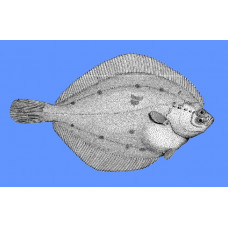Latin name
Pleuronectes quadrituberculatus
Other name
Pleuronectes pallasii, yellow-bellied flounder, yellow belly sole, lemon sole, tsunogarei
Identification
The ocellar bony ridge of the Alaska plaice is divided into 4-8 bony tubercles and forms a straight row between the eye and the lateral line. The body is covered with fine cycloid scales. Behind the eye are 5-6 conical tubercles. There are about 80 scales on the lateral line. The teeth on the jaws are incisor-shaped, on the lower pharyngeal bones bluntly conical, but some posterior teeth are chisel-shaped.
Features of fish fins
Dorsal spines (total): 0; Dorsal soft rays (total): 63 - 74; Anal spines: 0; Anal soft rays: 47 - 55.
Fish colouring
The ocular side of the Alaska plaice is brownish with dark indistinct markings that are also present on the fins. The blind side is yellowish.
Distribution
Occupies the northwestern Pacific Ocean: from Peter the Great Bay to Point Hope Cape in the Chukchi Sea, south to Unalashka Island, and east to Kayak Island in southeastern Alaska.
Habitat
A marine bottom fish that inhabits the sandy bottom of the continental shelf at depths down to 600 meters.
Size
The maximum body length of fish of this species is 87.0 cm, usually averaging up to 36 cm. Maximum recorded weight is 3.5 kg. The maximum recorded age is 37 years.
Behavior
Occurs throughout the coastal zone of the Far Eastern seas. Settles on the shelf and in the upper parts of the continental slope. Characterized by well-defined seasonal migrations. In summer, aggregations are distributed at depths less than 100 m, mainly 20-70 m, with bottom temperatures ranging from -1.0 to +8 °C. In late fall, aggregations shift to areas at the outer edge of the shelf, and in winter they are already at depths of more than 100-150 m, mainly up to 300m, with bottom temperatures of 2-4 °C. Some fish remain on the shelf for the winter at depths less than 150 m with bottom temperatures ranging from -1.7 to +1-4 °C.
Food and feeding habits
It feeds mainly on polychaetes and amphipods. In the northern part of the Sea of Japan, polychaetes and molluscs play the main role in the diet, and to a lesser extent ophiurae. Small individuals consume more worms than large individuals. The diet is more diverse off the east coast of Sakhalin Island. In addition to polychaetes and mollusks, actinia, fish (Ammodytes hexapterus), and occasionally crustaceans (Gammaridae) are recorded. In the southeastern part of the Bering Sea, the feeding spectrum is even broader: the main groups - polychaetes, molluscs, crustaceans - are equally represented, while other objects (ascidians, shrimps, fish) are much more abundant in stomachs (4-17% of occurrence) than in other areas. The most active feeding was observed during the evening and night hours.
Reproduction
Spawning is single. Eggs are pelagic, diameter of fertilized eggs 1.9-2.05, cf. 1.95 mm. Eggs are often carried by currents to great depths in the open sea; some move closer to the shore. Their development before hatching lasts 15-18 days under natural conditions at temperatures from 4.8 to 9.2 °C; at temperatures from -1.54 to +3.92 °C it probably lasts about 2 months. The length of hatched larvae is 5.6-5.85 mm. As a rule, small larvae are kept in the upper water layers, but individuals have been recorded at depths of 50-120 m. Metamorphosis begins at lengths of 9.46-9.96 mm. Juveniles 58.1-87.2 mm long are distributed in coastal areas at depths of 5-20 m. Growth is relatively slow, reaching a length of 45-47 cm at the age of 14-15 years. Sexual maturity occurs when males reach 20-30 cm in length at the age of 3-4 years, and females 22-39 cm and 5-7 years, respectively. Fecundity is relatively low: 80-250 thousand eggs.
Fishing
Targeted by fisheries. Most commercial fisheries do not target this fish, and bycatch by commercial trawlers targeting other groundfish is the only source of significant catches of this species.
Relationship with a person
Harmless. This fish is characterized by high flavor qualities.
| Classification | |
| Phylum | Chordata |
| Class | Actinopterygii |
| Squad | Carangiformes |
| Family | Pleuronectidae |
| Genus | Pleuronectes |
| Species | P. quadrituberculatus |
| Features | |
| Conservation status | Least Concern |
| Habitat | Bottom |
| Life span, years | 37 |
| Maximum body weight, kg | 3,5 |
| Maximum length, cm | 87 |
| Sailing speed, m/s | No information |
| Threat to people | Edible |
| Way of eating | Planktonophage |
Alaska plaice
Tags: alaska plaice

